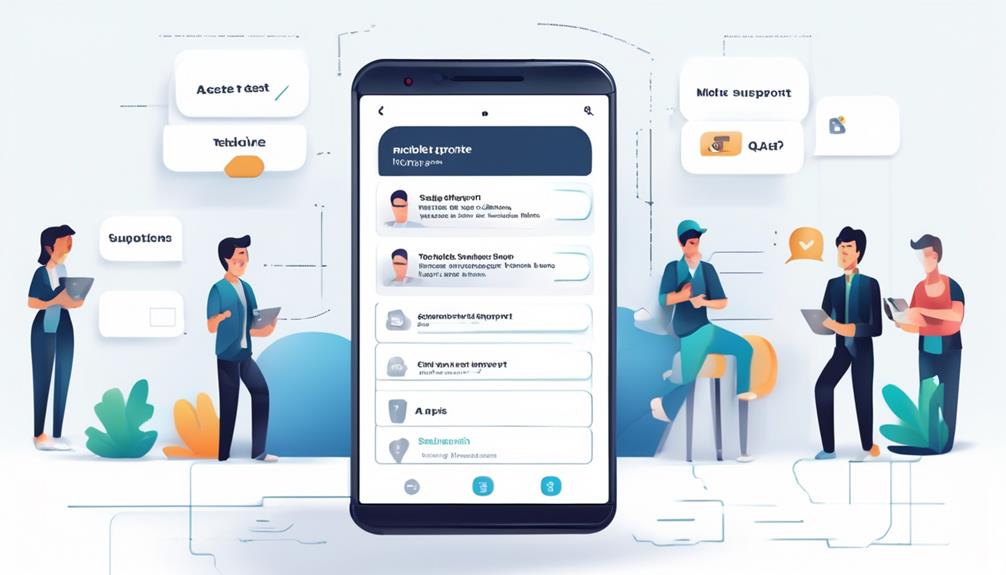We have all encountered the annoyance of trying to use a mobile app that is not functioning properly or living up to our expectations. Nonetheless, there are six documented tactics for mobile app quality assurance that can assist in resolving this matter.
From test automation to real device testing, these techniques are essential for ensuring the quality and success of mobile app development. But how exactly do they work, and what are the best practices for implementing them?
Let’s explore these techniques and dive into the world of mobile app QA to uncover the secrets behind their effectiveness.
Key Takeaways
- Platform testing across different operating systems and devices is crucial for ensuring consistent app performance and user experience.
- Customer-centric testing and user experience analysis are essential for evaluating usability, intuitiveness, and gathering direct feedback from end-users.
- Thorough functionality testing and quality assurance help ensure that every feature and aspect of the app is working as intended.
- Performance testing and optimization are important for addressing performance bottlenecks, scalability issues, and improving app stability and responsiveness.
Platform Testing
When conducting platform testing for mobile apps, we meticulously assess the app’s functionality and user experience across various platforms, such as Android, iOS, and web-based environments. This involves testing on real devices to ensure that the app performs consistently across different operating systems and devices.
For native apps, platform-specific testing techniques are essential due to the variations in control and maintenance across different platforms. Similarly, while functional testing approaches for native and hybrid apps may overlap, platform-specific testing is crucial for comprehensive coverage.
Web-based apps, on the other hand, require testing across different browsers and screen sizes to guarantee optimal performance and user experience. Performance and load testing are particularly vital for web-based apps to ensure stability and responsiveness across platforms.
Customer-Centric Testing

When it comes to customer-centric testing, our focus shifts to usability testing and user experience analysis.
We aim to understand how customers interact with the app and prioritize functionalities that directly impact their experience.
Usability Testing
Usability testing, a crucial phase in mobile app QA, focuses on evaluating the app’s user-friendliness and intuitive design from the customer’s perspective. It involves observing real users to identify potential usability issues and improve the overall user experience. Tasks such as navigation, feature usage, and feedback collection gauge customer satisfaction and ease of use. Customer-centric testing ensures the app meets the needs and expectations of the target audience, leading to higher user engagement and satisfaction. This approach helps in identifying and addressing usability issues early in the development process, ultimately enhancing the app’s market acceptance and success.
| Best Practices for Usability Testing | |
|---|---|
| Involve real users in the testing process | |
| Use a combination of qualitative and quantitative data collection methods | |
| Continuously iterate based on user feedback |
User Experience Analysis
To comprehensively assess the user experience of a mobile app, we employ Customer-Centric Testing, which focuses on understanding and improving the app’s usability and customer satisfaction. This approach involves evaluating the app from the user’s perspective, considering factors such as ease of use, intuitiveness, accessibility, and overall user satisfaction.
By prioritizing the user’s needs and preferences, Customer-Centric Testing helps in creating a mobile app that resonates with its target audience. It aims to gather direct feedback from end-users to drive improvements in the app’s design, functionality, and overall user experience.
Incorporating best practices in User Experience Analysis ensures that mobile apps meet the highest standards of usability and customer satisfaction, ultimately leading to greater user engagement and loyalty.
Functionality and UX Testing
When it comes to functionality testing, we ensure that every feature and aspect of the app is working as intended.
By testing real-time scenarios and natural app interactions, we can validate the user experience and identify any potential issues.
Incorporating user feedback into the testing process allows us to refine and optimize the app based on actual customer interactions, ensuring that usability and UI testing focus on intuitive app usage and efficient functionality.
Functionality Testing Importance
Ensuring the seamless functionality and user experience of a mobile app through thorough testing is crucial for its overall reliability and user satisfaction. Here’s why functionality testing is of utmost importance:
- Reliability: Functionality testing ensures that the app performs consistently and reliably under various user interactions.
- User Satisfaction: By identifying and addressing bugs early, functionality testing enhances user satisfaction through a smooth and error-free experience.
- Optimized Performance: Thorough testing allows for the optimization of key app functions, promoting user-friendly experiences.
- App Standards: Functionality testing helps in upholding the desired standards for app functionality and user experience.
In the realm of mobile app testing, incorporating best practices, including automated testing, is essential for achieving comprehensive functionality and UX testing.
UX Testing Best Practices
Functionality testing’s significance extends to the realm of UX testing best practices, where attention to detail and methodical analysis are critical for ensuring a seamless user experience. When conducting UX tests, it is important to consider natural app gestures/interactions, operating systems, and gesture testing. By implementing effective testing strategies, such as testing on real devices, early testing, and data-driven testing, app developers can ensure that the app delivers a consistent and intuitive user experience. To visualize the significance of UX testing best practices, consider the following table:
| UX Testing Best Practices | Description |
|---|---|
| Natural App Gestures/Interactions | Test how the app responds to natural gestures and interactions. |
| Operating Systems | Ensure the app functions seamlessly across different operating systems. |
| Gesture Testing | Validate the accuracy and responsiveness of app gestures. |
Adhering to these best practices will contribute to a positive user experience and enhance the overall quality of the app.
Real Device Testing

Real device testing provides accurate and realistic results for mobile app testing, ensuring comprehensive evaluation of performance and compatibility across various devices. When it comes to testing mobile apps, real device testing offers several benefits that contribute to the overall quality of the app.
Here are four reasons why real device testing is essential:
- Identifying Device-Specific Issues: Real device testing allows us to uncover issues that are specific to certain mobile devices, which may not be evident when using emulators. This ensures that the app functions seamlessly across a wide range of devices.
- Comprehensive Performance Tests: Testing the app on real mobile devices enables us to conduct thorough performance tests, simulating real-world usage scenarios. This helps in identifying any performance bottlenecks and optimizing the app for a smooth user experience.
- Ensuring Compatibility: Real devices allow us to test various scenarios, ensuring that the app is compatible with different devices, screen sizes, and resolutions. This is crucial for delivering a consistent user experience.
- Supplementing Automated Testing: While automated testing is valuable, manual tests on real devices provide an additional layer of assurance, especially in validating the app’s functionality in diverse real-world conditions.
Performance Testing

With the aim of optimizing app stability and responsiveness, performance testing is a crucial phase in the mobile app quality assurance process, allowing for the identification of performance bottlenecks and scalability issues. To conduct effective performance testing, a combination of automated testing and manual tests is often employed. Load testing, a type of performance testing, simulates high user traffic to assess the app’s performance under stress. This is crucial for ensuring that the app can handle the expected volume of users without crashing or slowing down. Performance testing also requires repetition to ensure more accurate results. Best practices for performance testing include allocating the necessary resources for testing, utilizing performance testing tools, and integrating performance testing into the overall development process. By following these best practices, app developers and QA teams can ensure that the app’s performance meets the expected standards and provides a seamless user experience.
| Types of Testing | Description | Benefits |
|---|---|---|
| Performance Testing | Evaluates app’s responsiveness and speed | Identifies bottlenecks and scalability issues |
| Load Testing | Simulates high user traffic | Assesses app’s performance under stress |
| Automated Testing | Uses automated tools for testing | Increases efficiency and accuracy |
| Manual Tests | Human-driven testing approach | Allows for flexibility and intuition |
Balanced Testing Approach

In our pursuit of a comprehensive mobile app quality assurance process, the transition from performance testing to a balanced testing approach is essential for ensuring thorough coverage of functionality and user experience. To achieve this, we need to leverage the best practices for mobile app QA and embrace a balanced testing approach that combines both automated testing and manual testing techniques.
Here’s how we can achieve this:
- Testing naturally evolves: Embrace the evolution of testing techniques by combining automated testing for repetitive tasks and manual testing for exploratory scenarios.
- Run Performance Testing Helps: Performance testing helps in identifying and rectifying bottlenecks, ensuring that the app functions optimally under various conditions.
- Utilize Real Device Testing and Emulators: Leveraging both real device testing and emulators is crucial for achieving accurate results and coverage across different devices and platforms.
- Hermetic Testing with Real-World Scenarios: Balancing hermetic testing with real-world scenarios is essential for effective testing, ensuring that the app performs as expected in real-life situations.
Cloud-based Device Testing

When it comes to mobile app QA, cloud-based device testing offers a multitude of benefits.
We can examine the advantages of cloud testing, such as scalability and comprehensive test coverage.
Additionally, we can explore best practices for cloud-based testing, ensuring efficient and effective mobile app quality assurance.
Benefits of Cloud Testing
Cloud testing offers comprehensive coverage by allowing testing on a wide range of real devices, including different OS versions and screen sizes.
The benefits of cloud testing are numerous, and they include:
- Enhanced Efficiency: With access to a large pool of real devices remotely, testers can save time and resources, reducing the need for physical devices.
- Scalability and Flexibility: Cloud-based testing allows for simultaneous testing on multiple devices, enhancing efficiency and test coverage.
- Compatibility Assurance: Testers can ensure that the app performs optimally across various environments by accessing the latest devices and OS versions.
- Faster Issue Resolution: Cloud-based device testing aids in faster debugging and issue resolution by providing instant access to diverse devices for comprehensive testing.
These best practices in app development and testing demonstrate the significant advantages of leveraging cloud testing for mobile app quality assurance.
Best Practices for Cloud-Based Testing
With careful consideration of diverse real-world conditions, cloud-based device testing ensures precise and realistic results, enabling thorough identification of device-specific issues and performance bottlenecks.
Testing mobile apps on a variety of real devices is crucial for accurate results, as emulators may not replicate real-world conditions effectively. Leveraging a real device cloud for testing provides more precise and realistic outputs, reducing time-to-market and offering access to thousands of devices for faster debugging and releasing.
Automated tests on real devices can simulate real user interactions, ensuring comprehensive testing across different devices.
Best practices for cloud-based testing involve utilizing services like Katalon Testcloud for efficient testing, which can offer app performance insights and easy device switching.
Modular Testing Process

The modular testing process in mobile app QA involves breaking down the app into smaller, manageable units for focused testing and quicker issue isolation. This method allows for a more systematic and efficient approach to testing, ensuring that every component is thoroughly examined.
Here are the key benefits of employing a modular testing process:
- Improved Testing Solutions: By testing individual modules separately, we can identify and address issues more effectively, leading to higher-quality testing solutions.
- Reduced Testing Time: Focusing on specific modules enables us to streamline the testing process, reducing overall testing time and accelerating the app development lifecycle.
- Enhanced Test Cases: Modular testing facilitates the creation of targeted test cases, ensuring comprehensive coverage of all app functionalities and scenarios.
- Better User Experience: Identifying and resolving issues at a modular level contributes to a more stable and reliable app, ultimately delivering a better user experience.
Real-time Scenario Testing

After thoroughly examining the benefits of employing a modular testing process, our focus now shifts to real-time scenario testing in order to ensure the app’s functionality and user experience across various real-world situations.
Real-time scenario testing is an essential aspect of mobile app testing, as it involves evaluating the app’s performance under real-time settings and conditions. This includes testing for poor network connectivity, different time zones, and GPS locations to ensure that the app functions effectively in diverse scenarios. By simulating natural app interactions, payment workflows, and geotargeting, real-time scenario testing aims to replicate real user scenarios and gestures, providing valuable insights into the app’s performance in real-world usage.
Furthermore, real-time scenario testing goes beyond mere device testing, as it offers a comprehensive understanding of how the app behaves under realistic user conditions. This facilitates the identification of potential issues that may not be evident during traditional testing methods.
Support Policy Testing

When it comes to support policy testing, it’s crucial to have a comprehensive overview of the policies in place. This involves analyzing test case scenarios and ensuring compliance with regulations.
Our approach should concentrate on the most widely used devices and operating systems to align with end-user data and market research.
Additionally, we should consider the necessity of supporting outdated platforms.
Support Policy Overview
Based on end-user data and market research, we define our support strategy to concentrate testing on devices and OS with the most end customers. By doing so, we ensure that our mobile apps are optimized for the platforms used by the majority of our real users.
Our support policy is constantly reviewed every three months to stay aligned with the dynamic mobile industry. To maintain efficiency, we avoid testing every set of browsers, platforms, and operating systems, focusing instead on the most prevalent ones.
Additionally, we consider limiting support for outdated platforms, allowing us to allocate our resources more effectively during the development process.
- Concentrating testing on devices and OS with the most end customers.
- Reviewing support policy every three months to stay up with the mobile industry.
- Avoiding testing every set of browsers, platforms, and operating systems.
- Considering limiting support for outdated platforms.
Test Case Scenarios
We will now explore the Test Case Scenarios for Support Policy Testing, ensuring that our focus on the most prevalent devices and operating systems is reflected in our testing approach.
When creating test case scenarios, it’s crucial to consider the functional testing requirements specific to the support policy. We need to prioritize automated testing for repetitive and time-consuming tasks, allowing for efficient coverage across various devices and operating systems. However, manual testing remains essential for validating user experience and identifying edge cases.
Compliance With Regulations
With a focus on aligning our support strategy with end-user data and market research, our approach to compliance with regulations in support policy testing emphasizes prioritizing testing efforts on platforms with the most significant end-user impact. When considering compliance with regulations for mobile apps, we must ensure that our support strategy is aligned with the needs and preferences of real users. To achieve this, we concentrate our testing on devices and operating systems with the most end customers, allowing us to prioritize our efforts where they’ll have the most impact.
Additionally, we consider the implications of limiting support for outdated platforms, and we regularly review our support policy to stay up to date with the fast-paced mobile industry.
- Concentrating testing efforts on platforms with the most significant end-user impact evokes a sense of purpose and efficiency.
- Aligning support strategy with real user data and market research fosters a customer-centric approach.
- Regularly reviewing support policy demonstrates a commitment to staying abreast of industry trends.
- Prioritizing testing on devices and operating systems with the most end customers showcases a focus on delivering quality experiences to the largest audience.
Refinement and Optimization

Refinement and optimization of a mobile app require continuous improvements to enhance its performance and user experience. Testing and manual testing play a crucial role in this process, allowing for iterative testing and data analysis to identify areas for refinement.
It’s essential to ‘Test Often’ to catch and fix issues early in the development cycle. Incorporating real user feedback is also vital, as it provides insights into user preferences and behaviors, guiding the refinement and optimization process.
Additionally, a robust test automation strategy is necessary for efficient testing of native and hybrid apps across different devices. A device lab can aid in testing the app on a wide range of real devices, ensuring its performance and compatibility.
Regular monitoring, analysis, and iteration of the testing process contribute to the ongoing refinement and optimization of the mobile app. By focusing on these aspects, we can systematically enhance the app’s performance and user experience, providing a high-quality product that meets user expectations.
Manual and Automation Testing Integration

Integrating manual and automation testing enables comprehensive and efficient testing across diverse devices, locations, and user experience scenarios. This approach combines the accuracy of automation testing with the adaptability of manual testing, ensuring thorough coverage.
Here are four key reasons why integrating manual and automation testing is essential for mobile app QA:
- Enhanced Efficiency: By incorporating regular automated tests alongside manual testing, the overall testing process becomes more efficient and effective.
- Comprehensive Coverage: Automation in white-box, load, and performance tests can significantly enhance the overall efficiency and effectiveness of manual testing, leading to more comprehensive coverage.
- Adaptability: It enables testers to identify the most appropriate testing approach for each feature and development phase, thus improving the overall testing process.
- Real User Testing: Integrating manual and automation testing allows for real user testing, ensuring that the app performs seamlessly in real-world scenarios.
This integration is crucial for achieving high-quality mobile applications that meet the diverse needs of users across various devices and locations.
Usability and UI Testing

To ensure comprehensive quality assurance for mobile apps, the pivot from integrating manual and automation testing seamlessly transitions into the critical process of Usability and UI Testing. Usability testing ensures that the mobile app is intuitive and easy to use, while UI testing focuses on the visual and interactive elements, ensuring a seamless user experience. Both forms of testing are essential for guaranteeing a high-quality app that meets user expectations. When conducting usability testing, it is crucial to cover critical end-to-end processes and include checks for data type errors in the test plan. For UI testing, the test plan should encompass checks for navigational elements, ensuring that users can effortlessly navigate through the app. Below is a table summarizing the key aspects of usability and UI testing:
| Usability Testing | UI Testing |
|---|---|
| Ensures app is intuitive and easy to use | Focuses on visual and interactive elements |
| Covers critical end-to-end processes | Includes checks for navigational elements |
| Includes checks for data type errors |
Test Automation Best Practices

Test automation best practices enhance the efficiency and effectiveness of mobile app testing, ensuring thorough coverage and early bug identification. When implementing test automation for mobile apps, it’s crucial to follow these best practices:
- Modular Test Design: Breaking down the app into smaller units allows for easier testing, debugging, and issue isolation. This approach also facilitates parallel test execution, saving time and effort.
- Real User Simulation: Utilizing real-world data and simulating user interactions enables testing of various scenarios, helping to identify bugs and issues early and ensuring app performance and scalability.
- Comprehensive Test Coverage: Test automation improves coverage and reduces human error through early and regular testing. This ensures that all critical aspects of the app are thoroughly tested, providing confidence in its quality and reliability.
- Integration and Continuous Delivery: Integrating test automation into the continuous delivery pipeline ensures that the app is rigorously tested at every stage of development. This facilitates early bug detection and swift issue resolution, ultimately leading to a more robust and reliable mobile app.
Frequently Asked Questions
What Are the Best Practices in Mobile App Testing?
We believe the best practices in mobile app testing involve:
- Early and regular testing to ensure desired functionality, quick feedback, and reduced bug fixing time.
- Utilizing test automation to save time and effort, identify bugs early, and improve test coverage.
- Testing on real devices to provide accurate results and identify device-specific issues.
- Smaller unit testing to allow for focused testing on specific features and easier issue isolation.
- Data-driven testing to provide realistic scenarios and ensure performance under different conditions.
How Do I Test My Mobile App for Qa?
We test our mobile app for QA by employing test automation to save time, find bugs early, and simulate user interactions.
Starting testing early in development and testing regularly ensures quick feedback and reduces bug fixing time.
Testing on real devices provides accurate results and ensures compatibility across various devices.
Smaller unit testing breaks down the app into manageable parts and improves test coverage.
Data-driven testing uses real-world data for realistic scenarios and performance testing.
How Can I Improve My Mobile App Testing?
We can improve our mobile app testing by implementing test automation to save time and effort, catch issues early, and simulate user interactions.
Testing on real devices, not just emulators, provides accurate results and identifies device-specific issues.
Breaking down the app into smaller units for testing makes it more manageable and improves test coverage.
Using real-world data for testing provides realistic scenarios and ensures app performance and scalability.
Which Is Best Tool for Mobile App Testing?
We’ve extensively researched the best tool for mobile app testing and found that it largely depends on the specific needs of your project. Factors such as budget, team expertise, and the app’s requirements play a crucial role.
Compatibility with platforms and technologies, a balance between manual and automated testing, and robust support and documentation are key considerations.
Careful evaluation will help you select the most suitable tool for your mobile app testing needs.
Conclusion
In conclusion, by integrating manual and automation testing, we can ensure a comprehensive approach to quality assurance.
The juxtaposition of platform testing and customer-centric testing allows for a balanced focus on both technical functionality and user satisfaction.
This attention to detail, combined with the methodical approach of usability and UI testing, ultimately leads to the refinement and optimization of mobile apps, ensuring their success in the competitive market.









